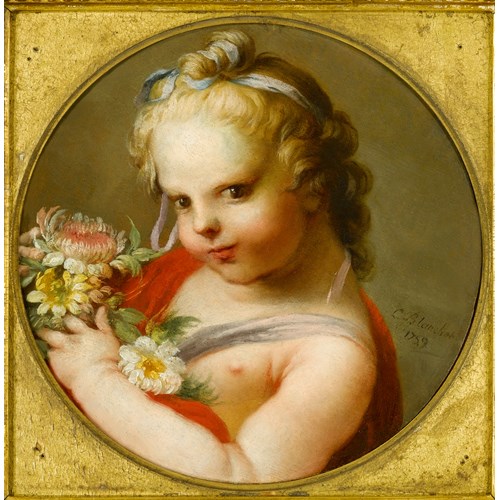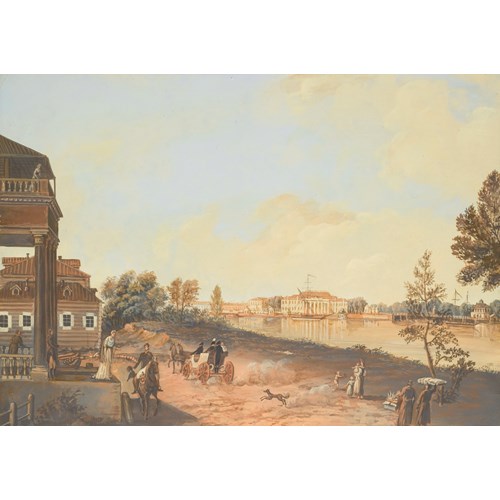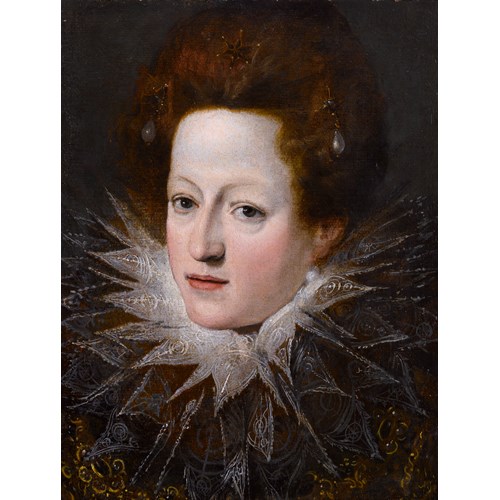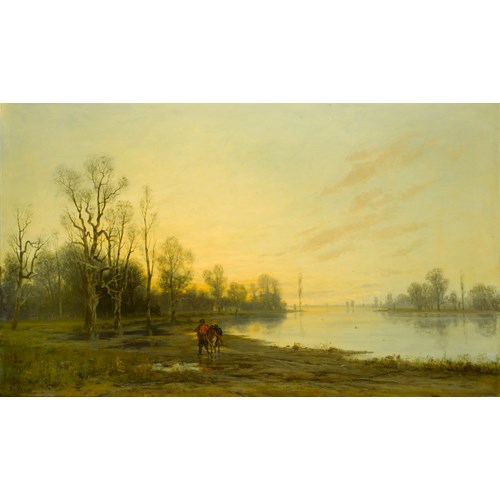Giovanni Andrea Carlone
The Sacrifice of Iphigenia
Period 1600-1750, 17th century
Origin Italy
Medium Oil on canvas
Dimension 115 x 166.5 cm (45¹/₄ x 65¹/₂ inches)
A majestic Artemis - Diana in Roman nomenclature - is made instantly recognisable by the accoutrements of her favoured pastime: a quiver of arrows and a hunting spear which are set at her left hand side. And in her right hand she wields a deadly golden bow though this time it is used to transform the original human sacrifice into an animal one. The luminous sparks from her bow crackle with life and imbue the painting with movement. It seems only fitting that the goddess of hunting is flanked by one of her lop-eared hunting dogs gifted to her by Pan, who peeps over the cloud she has conjured up to veil onlookers in confusion. In the Greco-Roman pantheon, Artemis’ other spheres of influence included the moon revealed by the crescent moon adorning the gold band that crowns her forehead.
In its composition, the scene is dominated by Artemis and Iphigenia’s father, Agamemnon, King of Argos. Cloaked in dazzling vermillion and richly wrought greaves, the king looks fearfully up at a stern Artemis. Carlone’s masterful use of perspective ensures that the confusion engendered in Agamemnon and his companions is palpable for his daughter is shielded from him by the mighty goddess. Nor can the stag yet be seen from behind the cloud the goddess has created. In the bottom left hand corner of the group’s arrangement, completing the diagonal line of Agamemnon and Artemis, a muscular figure caught in full motion reaches up to the departing figure of Iphigenia. Grasping a lethal knife, it seems likely that the grisly task of executing Iphigenia would have fallen to him. The whole composition is beautifully balanced with the group of three figures, including Calchas, gazing in bewilderment at the altar. In the bottom right quadrant, a mother and child and a handsomely dressed soldier avert their eyes in anticipation of Iphigenia’s gruesome death. A bizarre image to the left of the mother’s outstretched hand shows a man clinging to a fantastical figure.
The myth of Iphigenia fascinated artists and writers alike from Sophocles, Euripides and Aeschylus to Goethe and Racine. In the realm of art, the etching with drypoint of Pietro Testa (1611-1650), seems to have been influenced by Tiepolo’s rendition of The Sacrifice of Iphigenia at Villa Valmarana in Vicenza.
This work as a whole is a superb example of the high Baroque style which Carlone adopted in a number of his other pieces. His exquisite use of chiaroscuro to model his groups of figures, most notably in the figure of the executioner, owe much to the painterly style of Carlo Maratti (1625-1713) under whom he studied whilst in Rome. An aesthetic integral to the Baroque style shines out of Carlone’s version of the Agamemnon’s sacrifice. The prime importance of emotional expression to artists of this period is reflected in Carlone’s decision to render the scene at this exact moment, just as Artemis is spiriting Iphigenia away. Carlone’s work simmers with energy and bears all the hallmarks of a Baroque artist’s attempts to transport their viewers to a higher emotional plane. From the late sixteenth century onwards, arousing the viewer’s passions through concentrated detailing of their subjects expressions, facial or gesticulative, became hugely important to the artist. The expressive resonances that Carlone creates in The Sacrifice of Iphigenia, largely through use of his figures’ hands are astonishing. Iphigenia’s helpless plight is underlined by her despairing hand gesture while Artemis’ disdainful authority is embodied in her resolutely held bow. In pity, the plumed soldier seated to Agamemnon’s left puts his hand over his heart, and in frustration, as his victim escapes, the executioner reaches up to the departing figure of Iphigenia.
One work of Carlone that has much in common with The Sacrifice of Iphigenia is his evocation of Dawn. One of his more mature works, it is based on Guido Reni’s Aurora which is housed in the Casino Rospiglioso, Palazzo Pallavicini in Rome and forms part of a ceiling decoration. The little putto accompanying a radiant Aurora strongly resembles the young infant nestling in his mother’s lap in the bottom right hand corner of the painting. The brooding backdrop to both subjects is also a distinctive trait of Carlone’s oeuvre, though the attractively realistic luminosity of Aurora’s female form would seem slightly incongruous in his more ambitious The Sacrifice of Iphigenia.
In terms of the depiction of his human figures, Carlone rarely has them facing the viewer straight on. Both Aurora and the goddess Artemis avoid the viewer’s gaze by turning sideways, lending a dramatic intensity to the pictorial narrative. The realistic folds of drapery in both paintings emphasise Carlone’s skill at combining a more naturalistic feel - displayed also in his rendition of the flowers held by Aurora - with the majesty of Italian Baroque painting.
Giovanni Andrea Carlone learnt much from his father, Giovanni Battista Carlone who was also a distinguished painter. Subsequently, however, his extensive travels throughout Italy, first to Rome, left a great mark on his painting style. In Rome he made contact with Giovanni Battista Gaulli who is credited with influencing his early ornamental style. In the 1660s Carlone worked in Perugia, painting the frescoes in the church of S. Filippo Neri. And with Gaulli, he worked on frescoes in Il Gesù in Rome painting a fresco of the life of St. Francis. The following decade he travelled to key art centres of many Italian territories: Naples, Messina and Palermo and from there to Venice, Padua, Ferrara, Bologna, Modena, Parma and Piacenza. In 1675 in a clear signal of his importance in Roman artistic circles, Carlone became a member of the Accademia di San Luca. Towards the end of his life, the artist worked with his brother in their native Genoa, frescoing two rooms in the Palazzo Rosso with an Allegory of the Arts and the Age of Mankind (1691-1692).
Carlone’s nomadic life style permeated his output. His paintings from Perugia and Foglino have much in common with the Umbrian artists. In contrast, his Roman works underline the profound influence Maratti had on his artistic development. The Genoese frescoes that he completed with Niccolò Carlone hark back to the style of his father and his famous contemporary Cortona. Yet he unites this with the High Baroque art of Gaulli and Maratti. By the close of the century, the artists of the Casa Piola had absorbed this high Baroque style, certainly in part due to Carlone’s work.
A word on provenance, Carlone’s The Sacrifice of Iphigenia, once formed part of the collection of the Martinez Pinillos family, who resided in Cadiz until the end of the nineteenth century. The family, of aristocratic lineage, descend from the Counts of Villanova. They moved to Cadiz, in 1835, where they founded the navigation company Pinillos. The original founder of the company was Don Miguel Martinez de Pinillos y Saenz de Velasco, who was an avid collector and philanthropist. Under the direction of his son Don Antonio, the family business prospered further, and as a result of the contacts made through the various trade routes, the collection of art also grew. In particular, given the strong connections with the ports of Naples and Genoa, the collection featured the names of the most important and influential artists from these cities, The Sacrifice of Iphigenia, by the Genoese Carlone being one such fine example.
We are grateful to Dr. Mary Newcome Schleier for proposing the attribution to Giovanni Andrea Carlone following first hand inspection of the painting.
Period: 1600-1750, 17th century
Origin: Italy
Medium: Oil on canvas
Dimension: 115 x 166.5 cm (45¹/₄ x 65¹/₂ inches)
Provenance: Possibly in the collection of Don Miguel Martinez de Pinillos y Saenz de Velasco during the early nineteenth century, but probably acquired by his son Don Antonio Martinez de Pinillos (1865-1923), Cadiz;
By direct descent to his daughter Doña Carmen Martinez de Pinillos, Cadiz;
Thence by family descent to the previous owners.
More artworks from the Gallery









